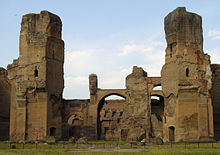This is an old revision of this page, as edited by Ezhiki (talk | contribs) at 22:09, 19 June 2005 (Reverted edits by 195.40.200.222 to last version by Longbow4u). The present address (URL) is a permanent link to this revision, which may differ significantly from the current revision.
Revision as of 22:09, 19 June 2005 by Ezhiki (talk | contribs) (Reverted edits by 195.40.200.222 to last version by Longbow4u)(diff) ← Previous revision | Latest revision (diff) | Newer revision → (diff)
The Baths of Caracalla were Roman public baths, or thermae, built in Rome between 212 and 216 CE, during the reign of the Emperor Caracalla. The extensive ruins of the baths have become a popular tourist attraction.
The Caracalla bath complex of buildings was more a leisure centre than just a series of baths. The "baths" were the second to have a public library within the complex. Like other public libraries in Rome, there were two separate and equal sized rooms or buildings; one for Greek language texts and one for Latin language texts.
In the early 20th century, the design of the baths was used as the inspiration for the design of Pennsylvania Station in New York City by the architect Charles McKim.
The ruins stand as the backdrop for the Teatro dell'Opera di Roma in the summer opera season.
External link
- Baths of Caracalla Virtual 360° panorama and photos.
This ancient Rome–related article is a stub. You can help Misplaced Pages by expanding it. |
This article about a European building or structure is a stub. You can help Misplaced Pages by expanding it. |